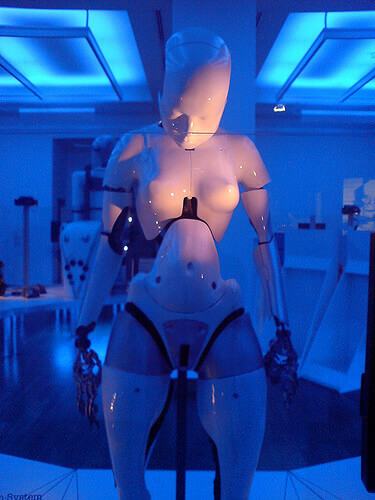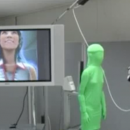An Open Letter to Sexbot Designers: You Can Do Better
Can we look beyond the mechanics of sex?

Before anything, a truly sincere compliment: the recent designers and builders of sexbots deserve a round of applause for their frankly staggering degree of engineering skill.
Recently we’ve seen passionate designers and manufacturers pouring amounts of time and resources into perfecting everything from a sexbot able to give perfect fellatio to creating ones that need to be seduced into sex.
It’s clear that we may very well be approaching a point where gynoids will be able to ace the Turing test for artificial intelligence and pass for a human—at least in regards to feeling sexually realistic.
Sex is not just engineering
Yet it’s this view of sex as being an engineering problem that needs to be solved that lies at the heart of what many are seeing as a fundamental problem with the direction gynoid design and manufacture is going.
Far too often it’s looking like these creations aren’t being built to enhance human sexuality but to build something that will replace women with an always willing, always skilled, replacement.
That is more than troubling. Some have even said that this line of design and manufacturing could even lead to a time when some men might look at real women as being just as unfeeling and even disposable as their plastic and metal doppelgangers.
The right to synthetic pleasure
Here’s where things get even more complicated. There are obviously some people who physically and even emotionally enjoy dolls. We have seen many iDollator’s, including those who have extensively documented their relationships with their synthetic partners.
Because of this, it would be unfair to call wanting to have sex with something like a gynoid “wrong.” If studies of human sexuality have taught us anything it’s that there is practically an infinite spectrum of desires and, as long as it is done safely and consensually, most forms of sex can be healthy.
What we need and what we want
It’s just that when you look at the current state of sexbot design, it’s become pretty disappointing. While so much work has been put into creating many types of gynoids, so little has been put into being truly imaginative about what a sexbot can be.
Some might argue that the market is driven by demand: that we see current sexbot prototypes because that’s what will sell. But that doesn’t explain why there are so many new female-oriented sex toys being developed and sold.
It also doesn’t explain the homophobia and non-binary gender issues so many sexbot designers show. Far too often the dolls are not just built for straight men, but in the rare cases when any bisexual or queer market is mentioned it’s mostly as a clumsy afterthought.
Fortunately, some manufacturers, such as Abyss Creations, the makers of the RealDoll line of love dolls, give the option to buy a form of transsexual doll—but this is the exception and not the rule.
It’s time to be imaginative
What we need is more than a few brave and daring engineers and designers to break the gynoid mold; to work to develop a completely new approach to a sexual pleasure doll or robot.
I |
For one thing, it’s time to acknowledge and respect the concerns of people who see gynoids as a new way to objectify women. Pretending it doesn’t exist does nothing but prove their point that sex doll and robot designers don’t care about anything but their satisfying their desires.
This is not denying the right to enjoying sexual pleasure with a doll or robot. But when you have a product that is pitched over and over again to be just as good as, if not better than, a real woman you should understand how others might see that as treating sex as mechanical, and women as just appliances.
We have seen some attempts at expanding the idea of what a doll or robot can be. The Samantha-bot, which has to be pleased and even stimulated before it will show signs of a simulated orgasm, is at least an attempt to consider the idea of consent in a synthetic but still has been criticized by making sex a game that a man has to play to win.
A doll that’s more than a doll
More than anything though, we need a sexbot that is not a replacement but an enhancement. There are many people on this planet who have a challenging time expressing affection or understanding what sex is and can be. Why not create special dolls or robots for them? A unit—for all genders and orientations—that would be a form of AI physical therapist: teaching how to touch and be touched, how to sexually relate to others?
 |
There are also lots of people with sexual anxiety around performance. So where are the dolls or humanoids for people who need help with everything from achieving orgasm to premature ejaculation? A sexbot wouldn’t ever replace a real therapist. But a special doll with a well-designed AI, that would offer encouragement and techniques, could be a huge help to a lot of people.
David Levy has pointed out that artificial lovers could help those trying to deal with loneliness. So why not create a model that would also act as an emotional guide, again offering encouragement as well as companionship? Let’s see love doll and sexbot manufacturers team up with psychologists and programmers. Again, it wouldn’t be as good as real human interaction, but for those who long for any kind of company, physical or otherwise, it’s better than being alone.
Then there are people with disabilities. That we haven’t seen a sexbot manufacturer step up to address their needs is shameful. Don’t know how to begin? Try talking to people with disabilities: find out their needs, their limitations, and make something perfectly suited for their sexual pleasure.
While there have been some remarkable developments lately, we are just at the beginning of a real sexbot revolution. New breakthroughs in artificial intelligence, smart materials, 3D printing, and so much more, promise that in the next few years we will be seeing an explosion of designs and possibilities.
It’s time for true innovation
Complicated, messy, strange, and also amazingly beautiful, sex is what makes us human. And with brilliant and imaginative approaches, we just might be able to create machines that will help humanity expand into new erotic vistas.
Image sources: Richard Giles, Mona Eberhardt, Sascha Pohflepp
Leave a reply
You must be logged in to post a comment.

















